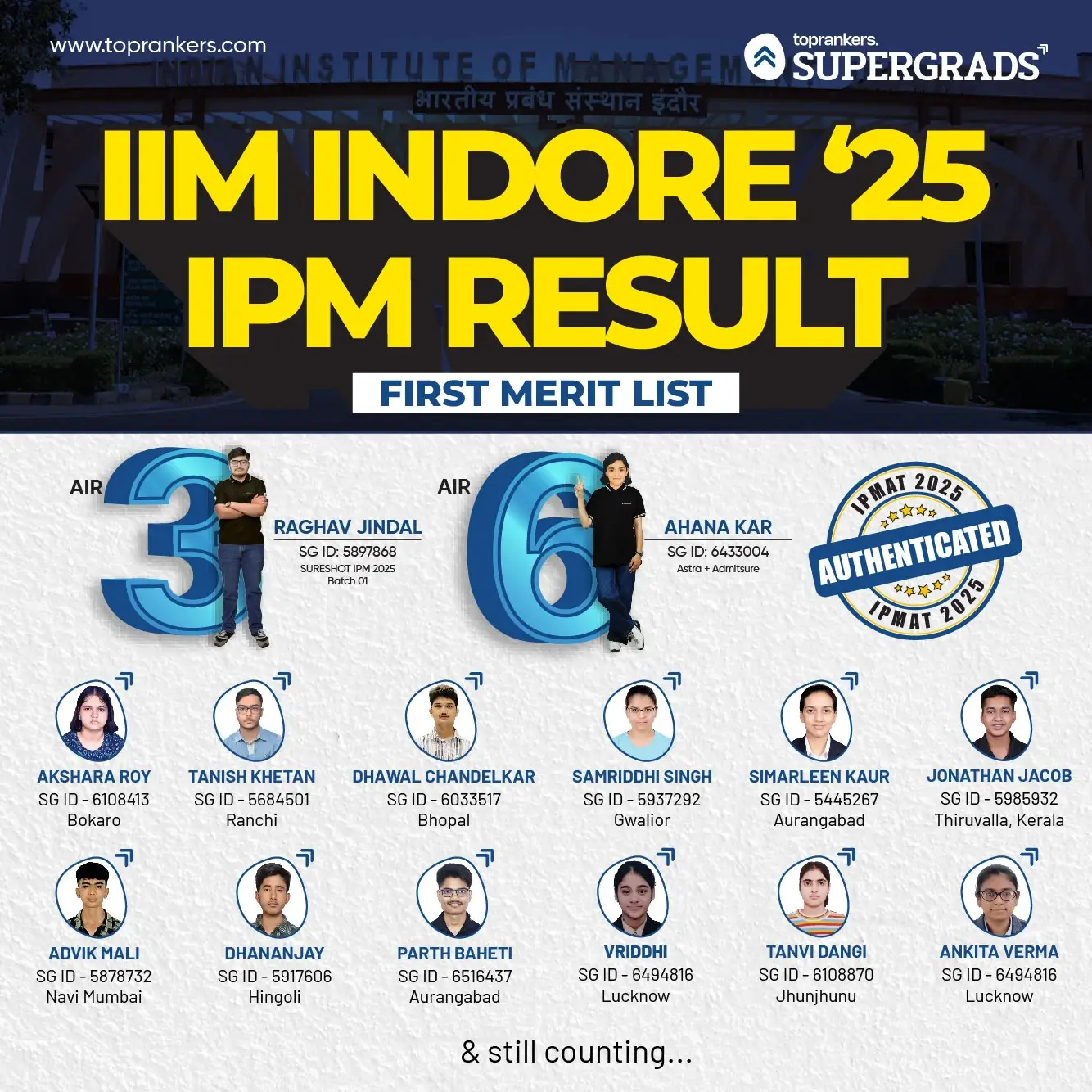NPAT Syllabus 2026: Section Wise Topics & Prep Tips
November 24, 2025
Overview: The curriculum for NPAT is vast, and you must know each subject and topic covered in the exam. Before proceeding with your preparations, you must carefully check the NMIMS NPAT syllabus 2026 to help you prepare an effective strategy for the exam.
Going through the syllabus of the NPAT exam lets you know which topics to study from each section.
Most of the questions in the NPAT Entrance Exam appear from topics like algebra, trigonometry, sets & functions, numerical reasoning, data interpretation, vocabulary, error recognition, and vocabulary.
This post provides a detailed overview of the NMIMS NPAT syllabus 2026 for management programs.
Know the important NPAT topics to be studied from each section.
Table of Contents
NMIMS NPAT BBA Syllabus 2026
As per the Syllabus of NPAT BBA, the questions are based on three subjects: quantitative and numerical ability, reasoning and general intelligence, and the English language.
Check out the detailed syllabus for the NMIMS NPAT entrance exam from the post below and plan your preparation accordingly.
Solving previous year's NPAT question papers will help you know the difficulty level of the paper and the type of questions asked in the exam.
Section-wise NPAT Exam Syllabus 2026
NPAT Syllabus 2026 for Quantitative Aptitude
In the quantitative section, you need to focus more on topics like number series, set theory, percentage, functions, linear & quadratic equations, profit & loss, time & work, height and distance, compound interest, fractions, surds, and decimals.
| Topic | Sub Topic |
| Number System | Fractions, Surds, and Decimals, Number Series. |
| Arithmetic | Percentages, Profit & Loss, Discount, Compound Interest & Annuities, Ratio & Proportions, Time, Work & Distance, 2D & 3D Figures- Areas & Volumes. |
| Algebra | Basic Algebraic Identities, Equations- Linear & Quadratic Sequence, and Series (AP, GP). |
| Sets and Functions | Sets, Operation on Sets and their Applications using Venn Diagrams, functions. |
| Elementary Statistics & Probability | Mean, Mode and Median, Measures and Dispersion. |
| Trigonometry | Trigonometric Ratios, identities, heights, and distances. |
NPAT Syllabus 2026 for Logical Reasoning
The logical reasoning section include sub-topics topics like decision-making, Venn diagrams, figure analogy, figure matching, and problem-solving. Practice NPAT mock tests to improve your time management skills and problem-solving skills.
| Topic | Sub Topic |
| Critical Thinking | Decision Making (Take into cognizance various rules/ conditions and take decisions based upon those rules/ conditions). Problem Solving (To analyze the given information and condense all the information in a suitable form and answer the questions asked). |
| Verbal- Logical Reasoning | Derive conclusions from logical premises or assess the validity of arguments based on statements of facts. |
| Data Sufficiency | Judge if the information given is sufficient to answer the question or if some additional information is required |
| Numerical Reasoning | Venn Diagram (Identify the class-sub-class relationship among given group items and illustrate it diagrammatically) Mathematical Equalities. |
| Data Interpretation | Be able to use the information given in graphs and charts to answer questions. |
| Spatial Reasoning | Figure Analogy (Choosing the figure from the alternatives that match with the relationship specified by a given figural pair) Figure Matching/ Classification (Notice the common quality in figures to be able to match figures or find the odd one out) Figure Series (To discover a pattern in the formation of figures in a sequence to be able to complete the series/ identify the missing figures). |
The below graph shows the number of questions asked in the NPAT Reasoning section.
NPAT Syllabus 2026 for Verbal Ability
In the verbal ability section, the questions are based on tenses, prepositions, grammar, determiners, connectives, grasping ideas, identifying relationships, interpreting ideas, moods, characteristics of characters, tone of a passage, inferring, getting the central theme, and evaluating.
Check out the table below to learn the NMIMS NPAT syllabus for English.
| Topic | Sub-Topic |
| Error Recognition | Identifying grammatical structure and usage |
| Applied Grammar | Using prepositions, determiners, connectives, and tenses adequately. |
| Vocabulary | Understanding the meaning of underlined words in sentences |
| Contextual Usage | Using appropriate words in the given context |
| Sequencing of Ideas | Putting ideas into logical sequence by putting jumbled sentences in the correct order. |
| Reading Comprehension (3 in Passages of 400-500 words with 5 Questions per Passage) | Locating Information, grasping ideas, identifying relationships, interpreting ideas, moods, characteristics of characters, tone of the passage, inferring, getting the central theme, evaluating |
Preparation Tips for NPAT Syllabus 2026
As you approach the NPAT 2026 exam, developing a robust preparation strategy is crucial to cover the extensive syllabus of NPAT effectively and efficiently.
Here are some targeted strategies to guide your NPAT study plan:
1. Syllabus Comprehension
- Understand the NPAT syllabus and focus on NPAT high-weightage topics.
- Break it down into smaller sections to study more effectively.
- Regularly review updates for any changes.
2. Structured Schedule
- Create a study timetable with set periods for each subject.
- Include time for breaks and revision to avoid burnout.
- Stay consistent with your schedule to track progress.
3. Use Recommended Resources
- Make use of textbooks, online materials, and past question papers.
- Stick to trusted resources that align with the NPAT syllabus.
- Practice from these materials to improve familiarity with the NPAT exam pattern.
4. Daily Practice
- Work on solving quantitative problems, reasoning puzzles, and verbal exercises daily.
- Build speed and accuracy by practicing time-bound questions.
- Consistent practice strengthens your foundation.
5. Mock Tests
- Take regular mock tests to simulate actual exam conditions.
- Analyze your performance after each test to identify areas needing improvement.
- Mock exams help boost confidence and manage time efficiently.
6. Focus on Weak Areas
Identify your weak subjects through regular assessments and mock tests.
Allocate extra time to review basics and solve additional problems.
Strengthen these areas gradually for better performance.
7. Balance Study and Relaxation
Maintain a balance between study and relaxation to stay fresh.
Take regular breaks, sleep well, and stay physically active.
A balanced lifestyle boosts focus and retention during study sessions.
Given the wide range and complexity of topics included in the NPAT syllabus, it is easy to become overwhelmed.
To assist you in understanding this intricacy, we have carefully developed a thorough reference describing each subject's syllabus for the NPAT 2026.
We advise you to explore the full NMIMS syllabus for NPAT and utilize this knowledge to create a personalized and successful study strategy.
NPAT Exam Pattern 2026
NPAT exam tests your proficiency in English and quantitative and logical reasoning skills.
Given below is the detailed exam pattern for NPAT 2026.
| Test | No of Questions | Time | Total Marks |
| Quantitative Reasoning | 40 | 100 | 40 |
| Logical Reasoning | 40 | 40 | |
| Verbal Reasoning | 40 | 40 | |
| Total | 120 | 100 | 120 |
Key Takeaways
- Comprehensive Syllabus: The NPAT syllabus 2026 includes Quantitative and Numerical Ability, Logical Reasoning & General Intelligence, and English Language. Understanding each topic is essential for effective preparation for NPAT exam.
- Quantitative Focus Areas: Key topics include number series, set theory, percentages, profit & loss, equations, time & work, and trigonometry.
- Logical Reasoning: This section covers decision-making, problem-solving, verbal reasoning, data sufficiency, and spatial reasoning. Regular practice is crucial.
- Verbal Reasoning: Topics include grammar, vocabulary, contextual usage, sequencing of ideas, and reading comprehension.
- Preparation and Cutoff: Develop a structured study schedule, use recommended resources, and take frequent mock tests. Be aware of the NPAT cutoff scores to ensure eligibility for NMIMS programs. Maintain a balance between study and relaxation to avoid burnout.
Frequently Asked Questions
How can I better prepare to cover the entire NPAT 2026 Syllabus?

What are the important topics that need to be prepared under Maths Section?

What are the best books for the preparation of the NPAT Exam 2026 Syllabus?

Which topic from Logical Reasoning contains maximum questions?

What topics are included in the English language of NPAT Syllabus 2026?

What topics are included under the Quantitative & Numerical Ability section of the NPAT BBA syllabus?









SHARE